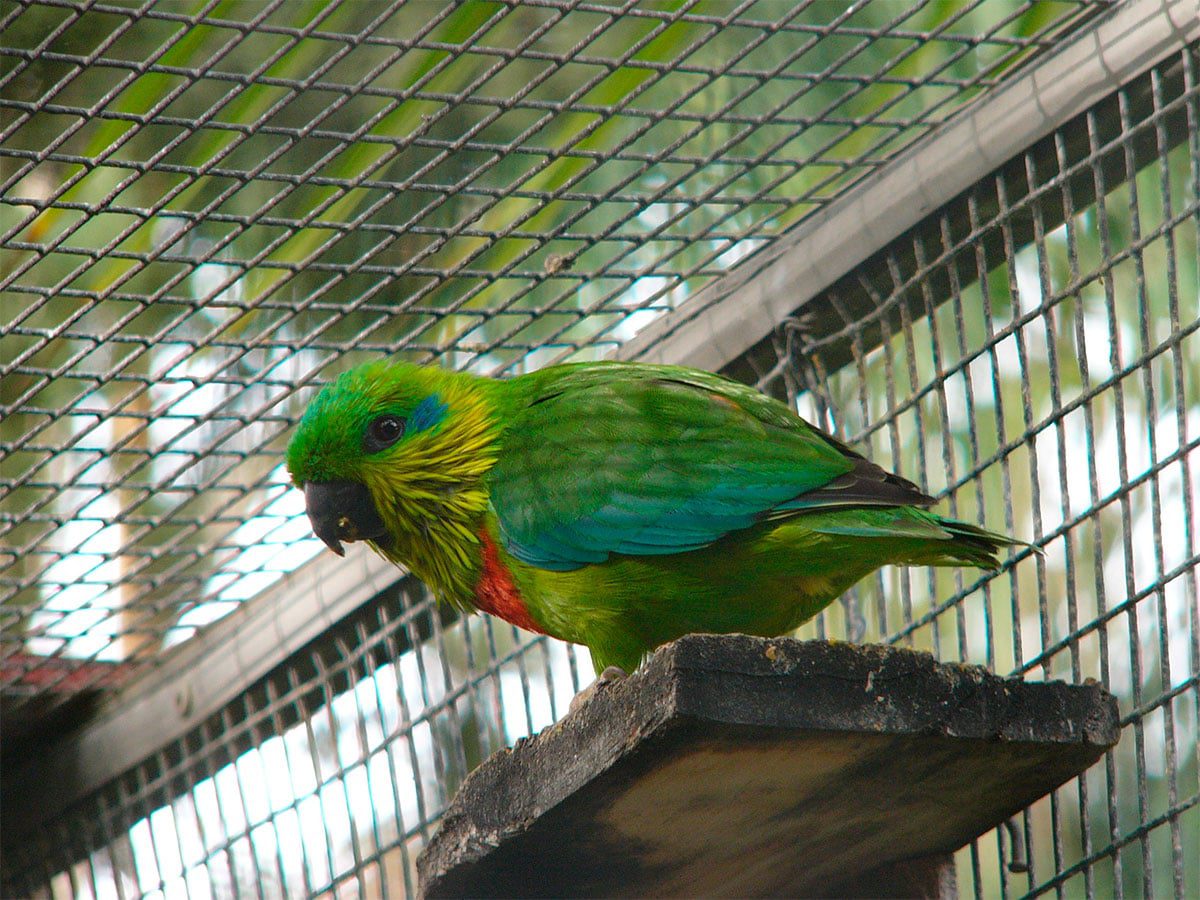Content |
|---|
Description
19 cm.. length and a weight of environment to the 118 g..
The forecrown and crown of the Salvadori's Fig-Parrot (Psittaculirostris salvadorii) is bright green with a little blue diffusion; cheeks and ear-coverts elongated yellow gold; area behind the eyes, pale blue: yellow the nape.
Upperparts green; internal parts of flight feather, orange-red at their ends. Under, the wings opaque green. Top of the chest with bright red band, rest of the underparts bright yellowish green, brighter and clearer than the upperparts. Upper, the tail green; Yellow below.
Bill black; irises red-brown; legs grey,
Female lacks the band scarlet chest, evident in the male, which it is substituted by a band It is showing some green opaque red feathers on the sides.
Youth equal to the adult female but duller overall; band pale blue chest, weak or invisible. Iris reddish brown.
- Sound of the Salvadori's Fig-Parrot.
Habitat:
The Salvadori's Fig-Parrot is distributed in the forests, along their edges, partially cleared areas and close to human settlements. Birds subsist mainly on the seeds of figs, and groups are fed into the cup of fruit trees, sometimes mixed with other species. Hang it upside down to feed, and they can make brief forays above the canopy. The species is found more often in pairs or in small groups, and nests colonies.
Reproduction:
Little is known about its ecology.
Food:
Their diet consists mainly of figs and other fruit.
Distribution:
Size of the area of distribution (reproduction / resident): 81.500 km2
THE Salvadori's Fig-Parrot (Psittaculirostris salvadorii) is endemic to the North of Irian Jaya, Indonesian. You can see in the forests of lowlands from the eastern edge of the Cenderawasih Bay to the humboldt bay (approximately 137 ° a 141 it is), reaching inside through the northern slopes of the Van Rees mountains to 700 meters above sea level. Not rare within its small range.
Conservation:
• Current IUCN Red List category: Least concern
• Population trend: Decreasing
This species is suspected of slow to moderate decline due to loss of habitat, limited degradation and some pressure for his capture.
Its population is estimated around the 10,000 specimens.
In the past, this species has been caught in relatively large numbers for the cage bird trade, both for the domestic and foreign markets, with a total of 1.582 birds exported from Indonesia between 1985 and 1990 (Beehler 1985, Nash 1990b , KD Bishop in litt., 1996, 1997to collar), and 1.791 between 1990 and 2001, When the species registered trade ceased (UNEP-WCMC 2007). But, the true extent of trade is unknown and is likely to be overlooked by many hunters in the preference of the most coveted and abundant species (B. Beehler in litt. 2012).
"Salvadori's Fig-Parrot" in captivity:
Susceptible to stress and disease.
Very rare in captivity.
Alternative names:
– Salvadori’s Fig-Parrot, Salvadori’s Fig Parrot, Whiskered Fig-Parrot, Yellow-cheeked Fig Parrot (ingles).
– Psittacule de Salvadori (French).
– Salvadorizwergpapagei, Salvadori Zwergpapagei, Salvadori-Zwergpapagei (German).
– Papagaio-dos-figos-de-salvador (Portuguese).
– Lorito de Salvadori (español).
scientific classification:
– Order: Psittaciformes
– Family: Psittaculidae
– Genus: Psittaculirostris
– Scientific name: Psittaculirostris salvadorii
– Citation: (Oustalet, 1880)
– Protonimo: Cyclopsittacus Salvadorii
Images "Salvadori's Fig-Parrot"
Videos "Salvadori's Fig-Parrot"
————————————————————————————————
“Salvadori's Fig-Parrot” (Psittaculirostris salvadorii)
Sources:
– Avibase
– Parrots of the World – Forshaw Joseph M
– Parrots A Guide to the Parrots of the World – Tony Juniper & Mike Parr
– Birdlife
– Photos:
(1) – Album parrots – parrots
– Sounds: Hans Matheve (Xeno-canto)


